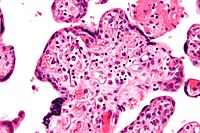
Photo from wikipedia
Fetal growth restriction (FGR) is associated with threefold to fourfold increased risk of stillbirth. Identifying FGR, through its commonly used surrogate—the small‐for‐gestational‐age (SGA, estimated fetal weight and/or abdominal circumference Click to show full abstract
Fetal growth restriction (FGR) is associated with threefold to fourfold increased risk of stillbirth. Identifying FGR, through its commonly used surrogate—the small‐for‐gestational‐age (SGA, estimated fetal weight and/or abdominal circumference <10th centile) fetus—and instituting fetal surveillance and timely delivery decrease stillbirth risk. Methods available to clinicians for antenatal identification of SGA fetuses have surprisingly poor sensitivity. About 80% of cases remain undetected. Measuring the symphysis‐fundal height detects only 20% of SGA fetuses, and even universal third trimester ultrasound detects, at best, 57% of those born SGA. There is an urgent need to find better ways to identify this at‐risk cohort. This review summarises efforts to identify molecular biomarkers (proteins, metabolites, or ribonucleic acids) that could be used to better predict FGR. Most studies examining potential biomarkers to date have utilised case‐control study designs without proceeding to validation in independent cohorts. To develop a robust test for FGR, large prospective studies are required with a priori validation plans and cohorts. Given that current clinical care detects 20% of SGA fetuses, even a screening test with ≥60% sensitivity at 90% specificity could be clinically useful, if developed. This may be an achievable aspiration. If discovered, such a test may decrease stillbirth.
Journal Title: Prenatal Diagnosis
Year Published: 2019
Link to full text (if available)
Share on Social Media: Sign Up to like & get
recommendations!